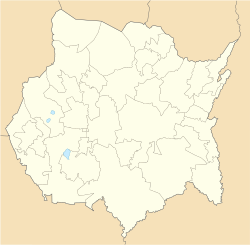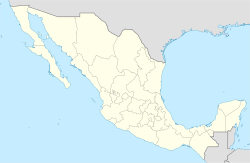Ciudad Ayala facts for kids
Quick facts for kids
Ciudad Ayala Nation
|
|
|---|---|
| Country | Mexico |
| State | Morelos |
| Government | |
| • Type | Ayuntamiento |
| Elevation | 1,147 m (3,763 ft) |
| Population
(2020)
|
|
| • Total | 89,834 |
| Time zone | UTC−6 (CST) |
| • Summer (DST) | UTC−5 (CDT) |
| GNIS feature ID | 04 |
Ciudad Ayala is a city in the central part of the Mexican state of Morelos. It's named after Coronel Francisco Ayala. He was a brave fighter with José María Morelos during the 1812 Siege of Cuautla. The town used to be called Mapachtlan. Ayala officially became a municipality on April 17, 1869.
In 2020, Ciudad Ayala had about 6,335 people living there. The city is the main center for the larger area called the Municipality of Ayala. This whole area had a population of 89,834 people in 2020. It covers an area of about 345.69 square kilometers. Some towns within the municipality, like San Pedro Apatlaco, Anenecuilco, and Tenextepango, are actually bigger than Ciudad Ayala itself.
The city was first known as San Francisco Mapachtlan. It was renamed in 1868 to honor Francisco Ayala (1760–1812). He was the first leader in the Morelos region to join the fight for independence in 1810. The town of Anenecuilco, where famous revolutionary leader Emiliano Zapata was born, is also in this municipality. So is the Hacienda de San Juan, near Chinameca, where Zapata was sadly betrayed and killed. Ayala is also famous because it gave its name to Emiliano Zapata's important plan, called the Plan of Ayala.
Contents
History of Ayala
Ancient Beginnings
Ancient ruins at a place called Olintepec show that people lived here as far back as 1500 BCE. These communities were at their busiest between 1200 and 1610 CE. The people of Olintepec were part of the Tlahuica culture. Other old ruins have also been found in a place called Tlayecac.
Becoming a Town
In 1603, a man named Don Nicolas Abad built a large farm, or hacienda, called San Francisco Mapachtlan. Twelve years later, this area grew into a larger settlement. In 1750, with help from Dominican friars, the people built their own church. They named it San José de Mapachtlan. This area was connected to Cuautla, Morelos. In 1834, it officially became a pueblo, which means a town.
In 1868, it became a municipalidad (a municipality) within the State of Mexico. It changed its name to Villa de Ayala to honor Francisco Ayala, a leader in the Mexican War of Independence. Later, on March 17, 1976, Ayala became a Centro de Poblacion, meaning a recognized population center.
Community Support During Challenges
During the COVID-19 pandemic in Mexico in 2020, the local government worked to help families. The municipal president, Isaac Pimentel Mejía, led an effort to give out 10,000 food baskets. These were given to families in more distant parts of the municipality.
Important People from Ayala
Many important figures have come from Ciudad Ayala or its surrounding areas.
- Coronel Francisco Ayala (Mexican Insurgent) (1760–1812) was a key leader in the fight for Mexico's independence. He was the first insurgent leader from the Morelos region.
- Eufemio Zapata (1873–1917) was the brother of the famous revolutionary leader Emiliano Zapata.
- General Pablo Torres Burgos (1877–1911) started a group called Melchor Ocampo in 1909. He became a general in 1911 and is known for his powerful words: "Down with the haciendas! Long live the people!"
- General Emiliano Zapata Salazar (1879–1919) was a legendary leader of the farming movement. He proposed the famous Plan de Ayala. Born in Anenecuilco, he was sadly killed in Chinameca. His famous saying was: "Land and Liberty."
- Otilio Montaño Sánchez (1887–1917) was the main thinker behind the Plan de Ayala. He was a general who fought with Zapata. In 1914, he became the Minister of Public Education.
Ayala's Economy
Industry and Jobs
The Cuautla Industrial Park is located in Ayala. It's a big industrial area, covering about 130 hectares. It's the second largest industrial park in Morelos. Most of the companies here are connected to making cars. Some of the biggest employers include Saint-Gobain (which makes glass), Sekurit (which makes car windshields), and Continental Automotive Temic (which makes industrial parts).
Farming and Tourism
Farming is a very important job in Ayala. Farmers grow crops like sugar cane, corn, sorghum, rice, onions, and zucchini. They also grow beautiful gladiola flowers. People also raise animals like cattle, sheep, horses, and chickens. Tourism is also a growing part of the economy, bringing visitors to the area.
Places to Visit in Ayala
Historical Sites
- The ancient ruins of Olintepec in Ciudad Ayala are very old, dating from 1500 BCE. They were most active between 1200 and 1610 CE.
- Tlayecac has old paintings and a small pyramid from ancient times.
- The Hacienda de San Juan near Chinameca is a very important historical place. General Emiliano Zapata was betrayed and killed here on April 10, 1919. This hacienda has now been turned into the National Museum of Agrarian Reform Movement. There's also a large statue of Zapata on the property.
- The parish church of San José in Ciudad Ayala is a beautiful old church. Its special day is March 15.
Emiliano Zapata's Legacy
- Anenecuilco is where Emiliano Zapata was born on August 8, 1879. His childhood home is now a museum. There's also a statue of Zapata in the town square.
- The parish church in Anenecuilco honors San Miguel Arcangel on September 29.
Other Attractions
- In Tenextepango, there's an old church dedicated to Santiago Apostol. His feast day is July 25.
- There are two small water parks: El Axocoche (or El Axochochetl) and El Colobri (the hummingbird). Both have parking and allow camping.
Communities and Celebrations
Ayala is made up of several communities, each with its own traditions and holidays.
- San Pedro Apatlaco is a farming community. They grow onions, beans, and corn. Their holidays are February 2 (Candlemas) and June 29 (Saint Peter).
- Anenecuilco is also a farming community. They grow sugarcane, corn, and gladiolus flowers. Their holidays include the fifth Friday of Lent, August 8 (Emiliano Zapata's birthday), and September 29 (Saint Michael the Archangel).
- Tenextepango is known for its vegetables like beans, corn, and zucchini, as well as sugar cane. It also has a very important annual fair on July 25 (James, son of Zebedee).
- Ciudad de Ayala is the main town. It's a farming community that grows sugar cane, corn, and rice. Its holidays are March 19 (Saint Joseph) and December 12 (Our Lady of Guadalupe).
- Jaloxtoc grows onions, corn, and sorghum. They also raise cattle.
- Tlayecac grows sorghum and corn. The industrial park is located here. Its local holiday is April 25 (Mark the Evangelist).
Other communities in Ayala include Chinameca, Huitzililla, San Juan Ahuehueyo, and Olintepec.
Ayala's Geography
Where is Ayala?
The municipality of Ayala is in the central part of the state of Morelos. It's about 1,220 meters (4,000 feet) above sea level. To the north are Yautepec and Cuautla. To the south are Tepalcingo and Tlaquiltenango. To the east are Temoac and Jantetelco. To the west are Tlaltizapán and Yautepec. Ayala is about 60 kilometers from Cuernavaca and 117 kilometers (73 miles) south of Mexico City.
Land and Hills
Ayala is located in the fertile Plain of Amilpas. The most important hills in the area are El Tenayo, El Aguacate, El Jimil, and Cerro Prieto. Each of these hills is about 1,500 meters (4,920 feet) high.
Rivers and Water
The Ayala River gets its water from several ravines. It flows south and eventually joins the Cuautla River. The Cuautla River then flows into the Amacuzac River, which is part of the larger Balsas River system. There are also smaller natural springs like Axocoche and El Colibrí. There is a dam in Palo Blanco.
Climate and Weather
Ayala has a warm and somewhat humid climate. On average, it gets about 800 mm (31 inches) of rain each year. The average temperature is around 24 °C (75 °F). The wind usually blows from the northeast to the southwest. The rainy season is from June to October, and the dry season is from October to June. April and May are the hottest months of the year.
Plants and Animals
The plants in Ayala are mostly from a type of forest where trees lose their leaves in the dry season. You can find trees like cubatas, casahuates, tulips, amates, framboyanes, and guamuchil. There are also fruit trees like Annona, cherimoya, mamey, plum, and guava.
Ayala is home to many different animals. You might see mammals like raccoons, badgers, rabbits, skunks, armadillos, and coyotes. Birds include magpies, buzzards, owls, and sparrowhawks. There are also iguanas and scorpions. In the rivers, you can find fish like catfish and mojarra.
See also
 In Spanish: Ciudad Ayala para niños
In Spanish: Ciudad Ayala para niños



